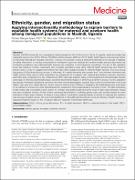| dc.contributor.author | Mangwi, Richard Ayiasi | |
| dc.contributor.author | Mangwi, Alice Jean Ochola | |
| dc.contributor.author | Young, Ruth | |
| dc.contributor.author | Orach, Christopher Garimoi | |
| dc.contributor.author | Morgan, Rosemary | |
| dc.date.accessioned | 2022-08-06T13:25:00Z | |
| dc.date.available | 2022-08-06T13:25:00Z | |
| dc.date.issued | 2022-07-29 | |
| dc.identifier.citation | Mangwi, R. A., et al (2022). Ethnicity, gender, and migration status: applying intersectionality methodology to explore barriers to equitable health systems for maternal and newborn health among immigrant populations in Masindi, Uganda.” Medicine 101 (30). https://journals.lww.com/md-journal/Fulltext/2022/07290/Ethnicity,_gender,_and_migration_status__Applying.8.aspx. | en_US |
| dc.identifier.uri | http://dir.muni.ac.ug/xmlui/handle/20.500.12260/463 | |
| dc.description.abstract | Globally, 298,000 women die due to pregnancy related causes and half of this occurs in Africa. In Uganda, maternal mortality has marginally reduced from 526 to 336 per 100,000 live births between 2001 and 2016. Health facility delivery is an important factor in improving maternal and neonatal outcomes. However, the concept of using a skilled birth attendant is not popular in Uganda. An earlier intervention to mobilize communities in the Masindi region for maternal and newborn health services discovered that immigrant populations used maternal health services less compared to the indigenous populations. The aim of this qualitative study was therefore to better understand why immigrant populations were using maternal health services less and what the barriers were in order to suggest interventions that can foster equitable access to maternal health services. Five focus group discussions (FGDs) (three among women; 2 with men), 8 in-depth interviews with women, and 7 key informant interviews with health workers were used to better understand the experiences of immigrants with maternal and newborn services. Interviews and FGDs were conducted from July to September 2016. Data were analyzed using content analysis and intersectionality. Results
were based on the following thematic areas: perceived discrimination based on ethnicity as a barrier to access, income, education and gender. Immigrant populations perceived they were discriminated against because they could not communicate in the local dialect, they were poor casual laborers, and/or were not well schooled. Matters of pregnancy and childbearing were considered to be matters for women only, while financial and other decisions at the households are a monopoly of men. The silent endurance of labor pains was considered a heroic action. In contrast, care-seeking early during the onset of labor pains attracted ridicule and was considered frivolous. In this context, perceived discrimination, conflicting gender roles, and societal rewards for silent endurance of labor pains intersect to create a unique state of vulnerability, causing a barrier to access to maternal and newborn care among immigrant women. We recommend platforms to demystify harmful cultural norms and training of health workers on respectful treatment based on the 12 steps to safe and respectful mother baby-family care.
Abbreviations: FGDs = Focus group discussions, IDI = In-depth interviews, MNCH = maternal newborn child health, USD = United States dollars. | en_US |
| dc.language.iso | en | en_US |
| dc.publisher | Wolters Kluwer Health | en_US |
| dc.subject | Ethnicity | en_US |
| dc.subject | Gender | en_US |
| dc.subject | Immigrant | en_US |
| dc.subject | Maternal | en_US |
| dc.subject | Newborn | en_US |
| dc.title | Ethnicity, gender, and migration status: | en_US |
| dc.title.alternative | Applying intersectionality methodology to explore barriers to equitable health systems for maternal and newborn health among immigrant populations in Masindi, Uganda | en_US |
| dc.type | Article | en_US |

